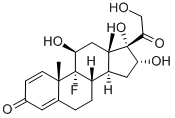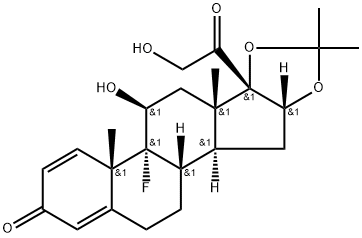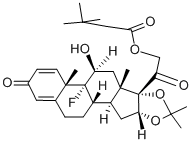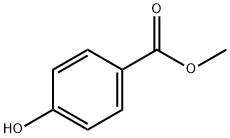Triamcinolone , 98% , 124-94-7
Synonym(s):
9α-Fluoro-11β,16α,17,21-tetrahydroxy-1,4-pregnadiene-3,20-dione;9α-Fluoro-11β,16α,17,21-tetrahydroxypregna-1,4-diene-3,20-dione;Fluoxyprednisolone
CAS NO.:124-94-7
Empirical Formula: C21H27FO6
Molecular Weight: 394.43
MDL number: MFCD00010477
EINECS: 204-718-7
| Pack Size | Price | Stock | Quantity |
| 500mg | RMB332.80 | In Stock |
|
| 2.5g | RMB1345.60 | In Stock |
|
| others | Enquire |
PRODUCT Properties
| Melting point: | 262-263 °C(lit.) |
| Boiling point: | 587.5±50.0 °C(Predicted) |
| alpha | 69 º (c=2, DMF) |
| Density | 1.1703 (estimate) |
| storage temp. | 2-8°C |
| solubility | DMF: soluble20 mg/mL |
| pka | 11.57±0.70(Predicted) |
| form | Solid |
| color | Crystals |
| optical activity | [α]25/D +69°, c = 2 in DMF |
| Water Solubility | 79.99mg/L(25 ºC) |
| Merck | 9595 |
| InChIKey | GFNANZIMVAIWHM-OBYCQNJPSA-N |
| CAS DataBase Reference | 124-94-7(CAS DataBase Reference) |
| NIST Chemistry Reference | Triamcinolone(124-94-7) |
| EPA Substance Registry System | Triamcinolone (124-94-7) |
Description and Uses
A natural extension of corticoid research involved examination of compounds containing both a 9α-fluoro group and a double bond between positions 1 and 2. Triamcinolone (9-fluoro-11β, 16α, 17, 21-tetrahydroxypregna- 1,4-diene-3,20-dione), introduced in 1958, combines the structural features of a ?1 -corticoid and a 9α-fluoro corticoid. As mentioned previously, the 9α-fluoro group increases the anti-inflammatory potency, but it also markedly increases the mineralocorticoid potency. This is undesirable if the drug is to be used internally for the treatment of rheumatoid arthritis. By inserting a 16α-hydroxy group into the molecule, one can decrease the mineralocorticoid activity.
A glucocorticoid, antiasthmatic (inhalant); antiallergic (nasal).
Safety
| Symbol(GHS) |  GHS08 |
| Signal word | Warning |
| Hazard statements | H351 |
| Precautionary statements | P280 |
| Hazard Codes | Xn |
| Risk Statements | 40 |
| Safety Statements | 22-36 |
| WGK Germany | 3 |
| RTECS | TU3850000 |
| HS Code | 2937220000 |
| Hazardous Substances Data | 124-94-7(Hazardous Substances Data) |
| Toxicity | LD50 subcutaneous in mouse: > 4gm/kg |




